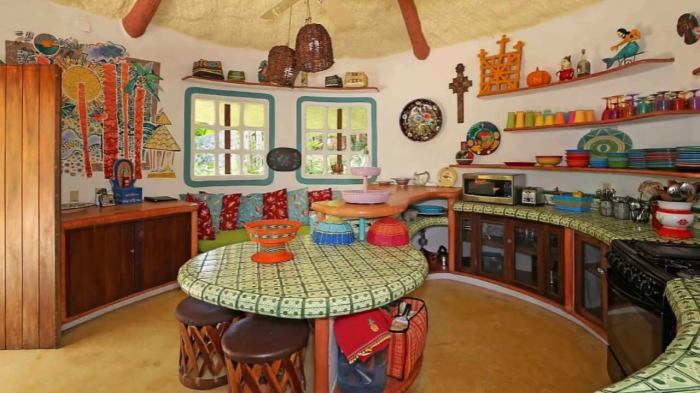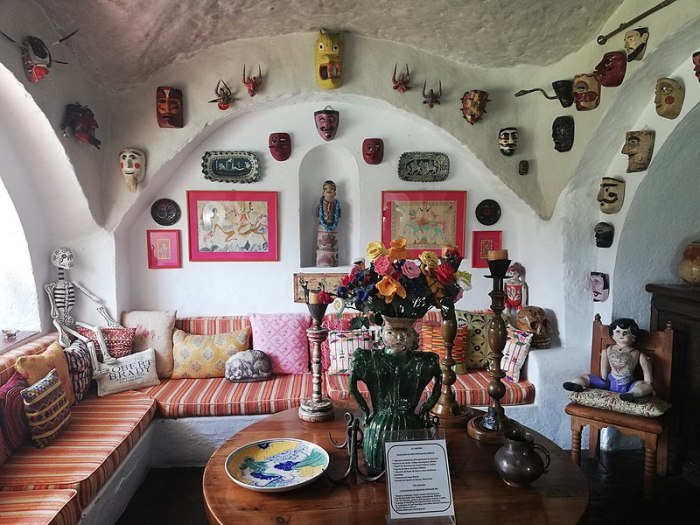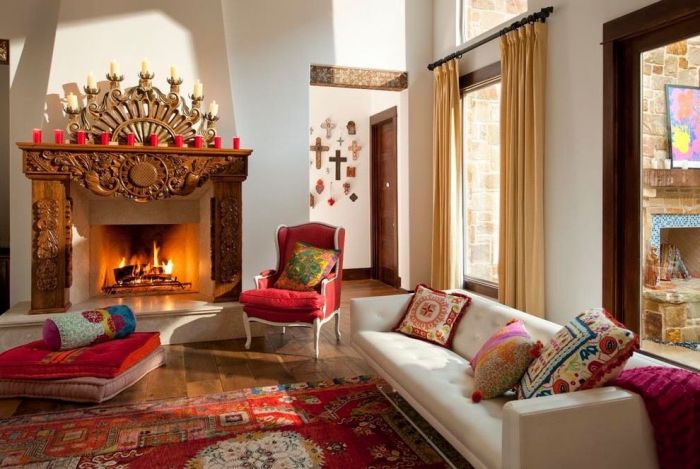Mexican Home Decor: A vibrant tapestry woven from centuries of tradition and artistry, Mexican home decor offers a captivating blend of color, texture, and handcrafted detail. From the sun-drenched hues of Talavera pottery to the intricate patterns of handwoven textiles, each element tells a story, reflecting the rich cultural heritage of Mexico. This guide delves into the diverse styles, key elements, and regional influences that define this unique aesthetic, providing inspiration for incorporating its warmth and character into modern living spaces.
We’ll explore the evolution of Mexican design, examining the distinctive characteristics of various regions like Oaxaca, Puebla, and Yucatan. Learn how to identify authentic pieces, blend traditional elements with contemporary styles, and source materials ethically, supporting the skilled artisans who keep these traditions alive. Whether you’re a seasoned design enthusiast or just beginning to explore the world of Mexican decor, this comprehensive guide will equip you with the knowledge and inspiration to create a truly unique and authentic space.
Defining Mexican Home Decor Styles

Mexican home decor, a vibrant tapestry woven from centuries of history and diverse cultural influences, offers a rich array of styles. Understanding these styles requires exploring both their traditional roots and regional variations, recognizing the evolution shaped by indigenous artistry, colonial legacies, and modern interpretations.
Traditional Mexican home decor is characterized by a warm, earthy palette, often featuring terracotta, deep reds, yellows, and blues. Handcrafted textiles, vibrant ceramics, and ornate wrought iron are prominent elements. The aesthetic is generally richly textured, reflecting a strong connection to nature and the country’s artistic heritage. Religious iconography, often depicted in colorful paintings or embroidered textiles, also plays a significant role, reflecting the deep-seated faith prevalent throughout Mexican culture.
Functionality blends seamlessly with artistry; furniture is often practical and durable, reflecting the values of resourcefulness and craftsmanship passed down through generations.
Regional Variations in Mexican Design
Mexican design varies significantly across its diverse regions, reflecting local materials, indigenous traditions, and historical influences. Oaxacan style, for example, is known for its intricate wood carvings, particularly in alebrijes (brightly painted fantastical creatures), and its use of black pottery. Pueblan design, influenced by its colonial past, incorporates Talavera pottery, known for its vibrant blues and whites, and features ornate furniture with intricate carvings.
In contrast, Yucatecan style, reflecting the region’s Mayan heritage, showcases natural materials like thatched roofs, woven hammocks, and brightly colored textiles, often incorporating Mayan motifs and patterns. These regional differences showcase the breadth and depth of Mexican artistic expression.
Evolution of Mexican Home Decor Styles
Mexican home decor has undergone a fascinating evolution. Pre-Hispanic styles, characterized by the use of natural materials and geometric patterns, laid the foundation for later aesthetics. The Spanish colonial period introduced European influences, blending with indigenous styles to create a unique hybrid aesthetic. This fusion is evident in the use of Spanish-style furniture, combined with indigenous textiles and ceramics.
The 20th century saw the rise of modern interpretations of traditional styles, incorporating elements of mid-century modern design while retaining the warmth and vibrancy of traditional Mexican aesthetics. Contemporary Mexican design continues to evolve, blending traditional elements with modern sensibilities to create unique and innovative spaces.
Example of a Traditional Mexican Living Room
Imagine a living room bathed in warm sunlight, its walls adorned with vibrant Talavera tile accents. The atmosphere is both inviting and richly textured.
| Furniture | Textiles | Decor | Lighting |
|---|---|---|---|
| A sturdy, hand-carved wooden armchair with intricately woven cushions | A brightly colored serape draped over the back of the armchair | A collection of hand-painted ceramic bowls and vases | A hand-forged wrought-iron chandelier casting a warm, ambient glow |
| A low, wide coffee table made from dark wood | A hand-woven wool rug in rich earth tones | A framed print depicting a religious scene or a vibrant landscape | Candles in decorative holders adding a touch of romantic ambiance |
| A small, ornate wooden side table holding a collection of family photographs | Embroidered cushions scattered on the sofa and armchair | A colorful ceramic tile mosaic adorning a section of the wall | Natural light streaming through a window draped with sheer linen curtains |
Key Elements and Materials

Mexican home decor is characterized by a vibrant blend of textures, colors, and handcrafted elements that evoke the rich cultural heritage of Mexico. The aesthetic is deeply rooted in the country’s diverse artistic traditions and readily incorporates natural materials, reflecting a connection to the land and a celebration of craftsmanship. Understanding the key elements and materials is crucial to recreating an authentic Mexican-inspired space.The most commonly used materials in Mexican home decor contribute significantly to its unique character.
These materials often possess a history and inherent beauty that enhance the overall design. The combination of these materials creates a layered and visually stimulating environment.
Common Materials in Mexican Home Decor
Talavera pottery, renowned for its vibrant colors and intricate designs, is a cornerstone of Mexican home decor. These hand-painted ceramic pieces, originating in Puebla, Mexico, range from decorative plates and bowls to functional sinks and tiles, adding a touch of handcrafted elegance to any space. Handwoven textiles, including rugs, blankets, and tapestries, often feature bold geometric patterns or intricate floral motifs, reflecting the diverse indigenous traditions of Mexico.
These textiles add warmth and texture, bringing a sense of handcrafted artistry into the home. Wood, particularly dark woods like mahogany or cedar, is frequently used in furniture and architectural details, contributing to a sense of richness and durability. Wrought iron, often adorned with intricate designs, is another popular material, used in furniture, light fixtures, and decorative accents.
Finally, natural materials like stone and terracotta are commonly used in flooring, walls, and decorative elements, adding a rustic and earthy feel to the space.
Color and Pattern Significance in Mexican Design
Color plays a vital role in creating the distinctive aesthetic of Mexican home decor. Vibrant hues, such as deep reds, sunny yellows, rich oranges, and earthy browns, are frequently used, often inspired by the country’s landscape and flora. These colors are often combined with contrasting shades to create a dynamic and energetic atmosphere. Patterns, frequently geometric or floral, are another essential element.
Traditional patterns, such as those found in indigenous textiles and Talavera pottery, often hold symbolic meaning, representing cultural heritage and beliefs. These patterns add visual interest and depth, contributing to the overall richness of the design. For example, the use of bold stripes might represent strength and resilience, while intricate floral patterns could symbolize abundance and prosperity.
The Role of Handcrafted Items, Mexican Home Decor
The prevalence of handcrafted items is central to achieving an authentic Mexican aesthetic. The unique character of each piece, reflecting the skill and artistry of the maker, adds a layer of warmth and personality that is difficult to replicate with mass-produced items. These handcrafted elements tell a story, connecting the space to Mexico’s rich cultural heritage and artistic traditions.
From hand-painted ceramics to intricately woven textiles, each piece contributes to the overall narrative of the space, creating a truly unique and personal environment. The imperfections inherent in handcrafted items add to their charm and authenticity, further distinguishing them from mass-produced alternatives.
Texture and its Contribution to Mexican-Inspired Spaces
The interplay of textures is another key element contributing to the overall feel of a Mexican-inspired space. The rough texture of plastered walls, often adorned with decorative finishes like stucco or limewash, provides a sense of rustic charm. This contrasts beautifully with the smooth texture of polished wood furniture, creating a dynamic visual interplay. The tactile quality of handwoven textiles adds another layer of textural interest, inviting touch and interaction.
The combination of these diverse textures creates a multi-sensory experience, enhancing the overall richness and authenticity of the design. For instance, a rough-hewn wooden table paired with a smooth, polished stone floor and a brightly colored, hand-woven rug offers a beautiful contrast of textures and colors.
Sourcing Authentic Mexican Decor

Bringing the vibrant spirit of Mexico into your home requires a discerning eye for authentic handicrafts. Understanding the nuances of genuine Mexican artistry ensures you acquire pieces that reflect rich cultural heritage and support the talented artisans who create them. This guide provides insights into identifying authentic pieces, finding reputable sources, and building a curated collection of truly Mexican decor.Identifying Authentic Mexican Handicrafts and Avoiding Imitations involves careful observation and understanding of traditional techniques.
Mass-produced imitations often lack the detail, craftsmanship, and unique imperfections that characterize handmade items.
Authenticity Indicators
Authentic Mexican handicrafts often exhibit subtle but significant characteristics. Look for hand-painted details, slight variations in color and pattern—a testament to the human hand—rather than perfectly uniform designs. Imperfections are not flaws; they are hallmarks of handcrafted artistry. Examine the materials; genuine pieces often use natural fibers like hand-spun wool or cotton, and traditional techniques like hand-weaving or embroidery will be evident.
Research specific regions known for particular crafts—Oaxaca for its textiles, Michoacán for its lacqueredware—to understand regional styles and techniques. The presence of a maker’s mark or a certificate of authenticity adds further assurance. Comparing prices can also be helpful; significantly lower prices than average may indicate an imitation.
Supporting Artisans and Preserving Traditional Mexican Craftsmanship
Purchasing authentic Mexican handicrafts directly supports the artisans and communities that create them. This economic empowerment helps preserve traditional skills and cultural heritage passed down through generations. By choosing authentic pieces, you become part of a story—a story of cultural preservation and economic sustainability. Look for fair trade certifications or organizations that ensure ethical sourcing and fair compensation for artisans.
This commitment to ethical practices adds another layer of value to your purchase.
Finding Reputable Sources for Mexican Home Decor
Locating authentic Mexican home decor involves exploring both online and offline avenues. Online marketplaces such as Etsy can offer a wide selection, but careful vetting is crucial. Look for sellers with detailed descriptions, high-quality images, and positive customer reviews. Check for information on the artisans and their origin. Physical stores specializing in imported goods or those directly associated with Mexican cultural centers offer a more hands-on experience, allowing for closer examination of materials and craftsmanship.
Visiting local markets in Mexico, if possible, offers the most direct route to sourcing authentic pieces directly from artisans.
Creating a Curated Collection of Authentic Mexican Decor
Building a curated collection involves a thoughtful approach, focusing on quality over quantity. Start by identifying your style preferences and the overall aesthetic you wish to achieve. Consider the types of items that resonate with you—perhaps hand-woven textiles, colorful pottery, or intricate metalwork. Research different regions and their specialized crafts to discover unique pieces that reflect your taste.
Prioritize quality over quantity; a few carefully chosen pieces will have a greater impact than a large collection of mass-produced items. Begin by sourcing a few key pieces—a striking hand-woven rug, a beautiful ceramic bowl, or a vibrant textile wall hanging—and build upon this foundation. Each addition should enhance the overall collection, creating a cohesive and authentic representation of Mexican artistry.
Incorporating Mexican home decor into your living space is more than just adding decorative elements; it’s about embracing a rich cultural heritage and bringing the warmth and vibrancy of Mexico into your home. By understanding the key elements, regional variations, and the importance of supporting authentic craftsmanship, you can create a space that reflects your personal style while celebrating the beauty and artistry of Mexican design.
From the bold colors and intricate patterns to the handcrafted textures and unique materials, Mexican decor offers a unique opportunity to infuse your home with character, history, and a touch of the magical spirit of Mexico.